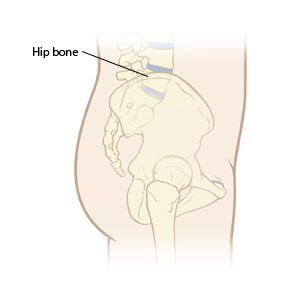Bone Marrow Aspiration and Biopsy
Bone Marrow Aspiration and Biopsy
Bone marrow is the soft, spongy part inside bones. It makes most of the body’s blood cells. Aspiration and biopsy are procedures done to take a sample of bone marrow out of the body for examination. For each procedure, a needle is inserted into one of your bones. This is often the back of the hip bone. Then a sample of bone marrow is removed.
If a sample of fluid and cells is taken, it is called bone marrow aspiration. If a solid sample of bone marrow tissue is removed, it is called bone marrow biopsy. In each case, the samples are sent to a lab and studied. The procedures can be done alone, but are most often done together. This sheet tells you more about what to expect.
Why the procedures are done
The procedures may be done for a number of reasons. They can help diagnose certain blood or bone marrow disorders or infections. They may help find certain cancers, such as leukemia. They can show if cancer in other areas of the body has spread to the bone marrow. They can be used during cancer treatment, such as chemotherapy, to monitor treatment progress. And they may be done before certain treatments, such as a stem cell transplant, which require a bone marrow sample. Your healthcare provider will explain why you need the procedure and answer any questions you have.
Preparing for the procedure
Prepare for the procedure as told. In addition:
Tell your healthcare provider:
What medicines you take. This includes blood thinners, such as aspirin. This also includes both prescription and over-the-counter medicines. And it includes herbs, and other supplements. You may need to stop taking some or all of them before the procedure.
If you are allergic to any medicines. Also mention if you have ever had a reaction to medicines used during other tests or procedures in the past.
If you have a history of bleeding problems.
If you are pregnant or think you may be pregnant.
Follow any directions you’re given for not eating or drinking before the procedure.
The day of the procedure
The procedures can be done at a hospital, clinic, or healthcare provider’s office. They are performed by a healthcare provider or trained healthcare provider. Whether you’re having one or both procedures, plan to be at the facility for 1 to 2 hours. You’ll likely go home the same day.
Before the procedure begins
What to expect before the procedure:
An IV (intravenous) line may be put into a vein in your arm or hand. This line supplies fluids and medicines.
You may be given a sedative to help you relax, if needed. This medicine is given by pill, injection, or through the IV line.
During the procedure
What to expect during the procedure:
You’ll lie on your side or your stomach.
The site to be used for the bone marrow samples is marked and cleaned. The most common site is the back of the hip bone. Less common sites include the front of the hip bone or breastbone.
Numbing medicine (local anesthesia) is injected at the site.
A small cut (incision) is made through the numbed skin.
One or both procedures are then done. Be sure to lie still for each procedure. It is normal to feel some pressure or pain during each procedure.
Bone marrow aspiration. A thin needle is put through the cut and into the bone. A syringe is then attached to the needle and used to remove a sample of bone marrow fluid and cells.
Bone marrow biopsy. A different needle is put through the same cut and into the bone. A small amount of bone marrow tissue is then removed.
The samples are sent to a lab to be evaluated.
When the procedure is complete, pressure is applied to the site to stop bleeding. The site is then bandaged.
After the procedure
Most people can go home after a short period of observation. If you need it, you’ll be given medicine to manage pain. If you were given a sedative, you may be taken to a recovery room to rest until the medicine wears off. An adult family member or friend must drive you home afterward.
Recovering at home
Once at home, follow any instructions you’re given. Be sure to:
Take all medicines as directed.
Care for the procedure site as instructed.
Check for signs of infection at the procedure site (see below).
Not get the procedure site wet. Do not bathe or shower until your healthcare providers say it is OK to do so. If you wish, you may wash with a sponge or washcloth.
Not do any heavy lifting and other strenuous activities as directed.
Call the healthcare provider
Call your healthcare provider if you have any of the following:
Fever of 100.4 ºF (38 ºC) or higher, or as directed by your healthcare provider
Signs of infection at the procedure site, such as increased redness or swelling, warmth, or bad-smelling drainage
Prolonged bleeding from the biopsy site
More pain around the biopsy site
Follow-up
Your healthcare provider will discuss the results with you when they are ready. This is often within a week after the procedure.
Risks and possible complications of these procedures
Complications are rare but include:
Severe bleeding or bruising at the procedure site
Infection at the procedure site
Bone break (fracture)
Bone infection
Updated:
May 12, 2018
Sources:
Bone marrow aspiration and biopsy: Indications and technique. UpToDate
Reviewed By:
Alteri, Rick, MD,Cunningham, Louise, RN,Gersten, Todd, MD,Image reviewed by StayWell medical illustration team.,Watson, L Renee, MSN, RN
